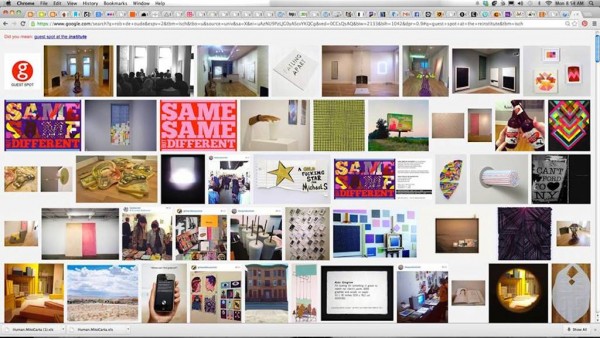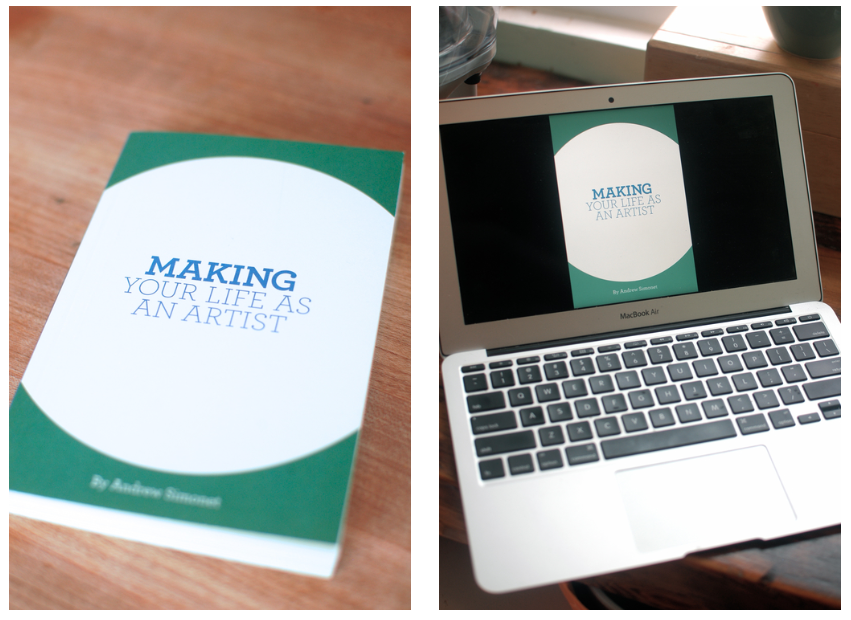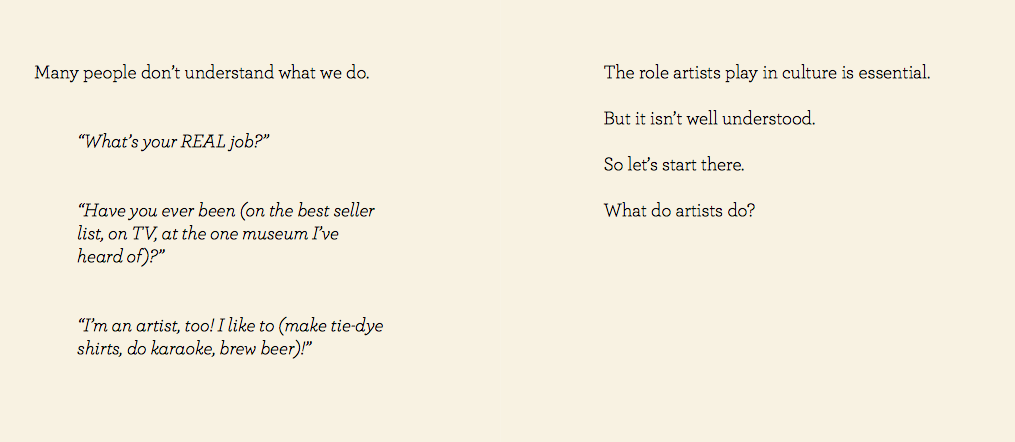Jack Livingston reviews MAKING Your Life as an Artist by Andrew Simonet
When I was in art school in Colorado many years ago, my friends and I were flush with the romanticism of being an artist, what our futures would bring. This was reinforced by our many inspiring teachers. Then, one day it was announced that our afternoon advanced painting class was canceled and in its place a visiting artist was to give a talk.
When I found out who it was (and I can’t remember his name) my interest waned. He was well known, respected, and wildly successful. His paintings were all purchased at high prices before they were finished and there was already a high-end coffee table book with reproductions of his work that sold well. The issue for me was the odious genre he worked in. It is known as ‘Western Painting.’ He painted realistic images of cowboys and Native Americans with a nostalgic bent, yearning for a time long past and often fictional. You know, the type of painting George W. Bush collected before he started painting dogs. This artist was at the top of the heap of the slew of such artists in the region working in the genre at that time.
When he visited, he spent little time talking about his own work or his personal aesthetic. Instead he took the entire afternoon to talk about his business practices and how he made a sustainable living as an artist. This included how he got started, worked with clients, dealt with contracts, galleries, studio space, and finally one of the most compelling aspects, and one that I had never considered at the time, how to establish a small business as a practicing artist, which included keeping books and all about current applicable tax laws. He talked and took questions and urged us all on with his positivist outlook. It was fascinating. That afternoon I learned more that has helped me through the ups and downs of my own life as an artist then any other information I have ever been given by anyone since. I still owe that guy great debt.
In this same spirit, choreographer, performance artist, and founder of Artists U, Andrew Simonet, has as written a highly readable book, titled MAKING Your Life as an Artist, that is full of compelling thoughts and advice on living a creative life, culled from many years of experience. A solid read for artists of all ages, it is now available through Artists U in paperback for eighteen bucks and, even better, by way of a free PDF – just a click away through the Artists U website.
Artists U was founded in 2006 in Philadelphia, and has expanded since that time to include a chapter in Baltimore. It was created as a grassroots organization, a kind of practical antidote to the world of more formal expensive art world educational institutions. It has a number of aspects, including an annual Artists Core Program, which chooses a dozen artists each year to meet eight times to address topics including, but not limited to, artist statements, grant writing, and communications. They run regular workshops for creative types addressing similar topics included in the book. On Mondays, the organization offers artists working in any genre ‘one on one’ planning meeting with a facilitator to create a strategic plan to problem solve.
Minutes after I downloaded a copy, I was engrossed with the material, which remained as relevant to my life today as it would have been twenty years ago. Its message prompted ideas for problems I face today. These days, most art schools have classes in professional development, and I have participated in them as a visiting artist, but Simonet brings something new and refreshing to the table. He is optimistic yet cautionary.
The book is well designed in its hardcopy and online edition. It is a swift and informal read, nothing daunting about it. The aesthetic is simple and clean, with the text surrounded by a lot of white space. The look of the book is retro sixties, much like a standard instruction manual from the period and in some ways so is the writing. Online, the book is wider than it is tall, so reads like thumbing through index cards covered with succinct notes, reinforced by two columns on each page with text. The right side often answers questions, or expands upon them, with statements posed on the left.
MAKING Your Life as an Artist is divided in ten sections, starting with The Roll of the Artist, and Our Punishing Lives and ending in three chapters titled Money, Time, and Principles respectively. It gets right to the point, avoids art-speak, and offers overviews along with smart solutions everyday problems. What is especially unique about the book is it speaks to all genres, including visual arts, performing arts, and music.
Also, it isn’t all just practical problem solving. Simonet is more reflective and philosophical than that. He addresses a number of issues that artists often have a hard time clarifying for themselves, let alone with others. In this way it is a bit of a self-help book, but unlike the many books in that genre, it is not cliché nor does it glorify the writer as some sort of guru.
In the first chapter, the author takes on the issue of why creative people are a valuable asset to society. With the second chapter, Simonet speaks to the stress of making a living as an artist— noting that artists are perfectionist workaholics producing much work yet often getting little in return. Then he proceeds to offer down to earth, sensible solutions to this issue. The entire book keeps up the pace from there, covering much territory through presented insights or questions and practical solutions. One sample of advice:
“Apply the skills, creativity, and resourcefulness of your art practice to the rest of your life.”
While this may sound like a feel good platitude in application, it is sound advice. Much of art practice, like science, is finding new paths and testing new ideas, then keeping the ones that work and discarding the rest. An artist (or any person) should never stop questioning and changing their strategies. If an artist applies this principle to how to structure their lives, it means they never remain static and can solve almost any problem or situation because they are adept at it, are comfortable with change, and know when to proceed or when to step away and move on.
I particularly like this statement from the book:
“No one is coming. No one is going to knock on your door and turn you from the artist you are now into an artist who has made it. That doesn’t happen. But there are many people who will partner with you to move your work forward. And you already know a lot of them.”
This may be the ultimate truism the book revolves around. Becoming famous and highly successful in the big time art world is like winning the lottery—only a very small minority of the millions of players has the ticket. It is most often by luck, having the right work, in the right place, at the right time, and knowing the right people—plus a lot of hard work and politicking. The vast majority of artists will not achieve this, not because they don’t deserve it, but because that is how the game is currently played. That said, all artists can make a mark and have a good sustainable lifelong career by partnering with like-minded people to create their own “scene” within which to operate and offer results to an appreciative audience. When you take charge of your life and work, and work well with and help others, people take note and respect you. This is a major building block towards creating a rewarding life, doing what you enjoy. In the end, compared to fame this type of stable sustained life may in fact be more rewarding and healthy.
These are but two small examples of the good advice to consider in this book. There are page after page of vital issues to consider.
MAKING Your Life as an Artist ends on ten principles, each of which is central to any artist, no matter what field they work in or what stage of their career they find themselves. I am not going to list them here because what I really want is for you to go and download the book and read them.
Simonet deserves much credit for providing a free, up-to-date accessible book that delivers all artists (no matter what stage your career is) important information to consider, without romanticizing or bullshitting – while maintaining a total belief in the artist as an integrated practitioner and the need for their sustainability and quality of life. His practical and positive views are succinct, and helpful. The reader may not agree with his every statement or conclusion, and they may find him too general at times, but that is not the point of the book. Its narrative is set to engage the reader in a thought provoking manner, to help them clarify for themselves and with friends what they think about the topics presented.
ARTIST U: MAKING Your Life as an Artist by Andrew Simonet
* Author Jack Livingston is a Baltimore-based Artist, Writer, and Editor. He is the founding editor of Radar and Radar Redux.









